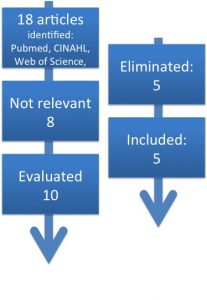Background
-
Therapeutic alliance (TA)- collaboration and affiliation between patient and therapist
-
Associated with better outcomes in general medicine and psychotherapeutic practices
-
Is the same pattern present in physical therapy? What specific outcomes are affected?

http://www.folklife.si.edu
Case Scenario and PICO
25 year old mother and student referred to PT for chronic low back pain over 6 months.
-
No red flags present, 42% dysfunction on Oswestry, AROM limited by pain
-
Patient fearful she will not improve
The treating PT after evaluation focuses sessions on reassuring patient, including minimal exercise. The facility manager, also a PT, says future sessions should involve more therapeutic exercise to maximize results.
For patients with musculoskeletal pain, does enhanced therapeutic alliance predict improved outcomes compared to limited therapeutic alliance or exercise alone?
Search Strategy
 Inclusion Criteria: Article Type: Systematic review, RCT. Date range: 2011 – Present. Age group: Adult >18, Outcomes: pain, function. Providers: PT, MD,RN. Intervention: Therapeutic Alliance, Motivational Enhancement
Inclusion Criteria: Article Type: Systematic review, RCT. Date range: 2011 – Present. Age group: Adult >18, Outcomes: pain, function. Providers: PT, MD,RN. Intervention: Therapeutic Alliance, Motivational Enhancement
Results

Clinical Bottom Line

http://www.shutterstock.com
Mixed quality evidence including high and low quality studies indicates that Enhanced Therapeutic Alliance
-
applies best to chronic low back pain patients
-
causes increased pain tolerance even without therex
-
correlates with better outcomes in function, pain reduction and perceived treatment effect
Limitations
-
Poor design of lower quality RCT’s
-
Multiple and under studied outcome measures
-
Lack of power analysis
-
Lack of replication
-
Use of VAS
-
Use of high tech sham treatment
Application

http://www.blackenterprise.com/
Specifically target therapeutic alliance in Chronic LBP populations using a Motivational Enhancement approach including:
-
Collaborative goal setting
-
Affirming symptoms
-
Adjusting exercises if patient is resistant
-
Seeing patient one-on-one until alliance is built & therapeutic exercise program well tolerated
-
Using an Alliance Survey, such as the Working Alliance Theory of Change Inventory
References
- Fuentes, J., Armijo-Olivo, S., Funabashi, M., Miciak, M., Dick, B., Warren, S., Rashiq, S., Magee, D.J. and Gross, D.P., 2014. Enhanced therapeutic alliance modulates pain intensity and muscle pain sensitivity in patients with chronic low back pain: an experimental controlled study. Physical therapy,94(4), pp.477-489.
- Hall, A.M., Ferreira, P.H., Maher, C.G., Latimer, J. and Ferreira, M.L., 2010. The influence of the therapist-patient relationship on treatment outcome in physical rehabilitation: a systematic review. Physical therapy.
- Ferreira, P.H., Ferreira, M.L., Maher, C.G., Refshauge, K.M., Latimer, J. and Adams, R.D., 2013. The therapeutic alliance between clinicians and patients predicts outcome in chronic low back pain. Physical therapy, 93(4), pp.470-478.
- Vong, S.K., Cheing, G.L., Chan, F., So, E.M. and Chan, C.C., 2011. Motivational enhancement therapy in addition to physical therapy improves motivational factors and treatment outcomes in people with low back pain: a randomized controlled trial. Archives of physical medicine and rehabilitation,92(2), pp.176-183.
- Tse, M.M., Vong, S.K. and Tang, S.K., 2013. Motivational interviewing and exercise programme for community‐dwelling older persons with chronic pain: a randomised controlled study. Journal of clinical nursing, 22(13-14), pp.1843-1856.